
Potato
Potato is the world’s 4th largest food crop following rice, wheat, and corn. Potatoes were first cultivated in Peru and Bolivia around 8,000 BC to 5,000 BC. The Inca Indians in Peru discovered a way to dehydrate and mash the potatoes, which they could store for a long time, and hence, potatoes became staple food in Peru.
In the mid-16th century, Spanish conquered Peru. They discovered the goodness of potatoes and carried them to Europe. Due its plain look and bland taste, people in Europe did not accept it as food and started using potatoes as livestock feed. However, the farmers in Europe found it easier to grow potatoes than other crops, hence potatoes became popular food crop there as well. Gradually, it spread around the world and has become staple food in many countries. Today, potato is grown in all 50 states in the USA and more than 125 countries throughout the world.
There are many varieties of potatoes categorized into starchy, waxy, and all-purpose types:
Starchy - Starchy potatoes are high in starch, low in moisture, and do not hold their shape well after cooking. Idaho Russet and Katahdin are examples of starchy potatoes. They are good for boiling, baking, and frying, but are not recommended for dishes like potato salads and casseroles which require firm-textured potatoes.
Waxy - Waxy potatoes are low in starch and are creamy and firm. They hold their shape after cooking. Red Bliss, Inca Gold, Fingerling, and New Potatoes are a few examples of waxy potatoes. This variety is excellent for cooking dishes that require firm potatoes, such as casseroles, potato salads, and gratin and can also be used for roasting, baking, boiling, and frying.
All-purpose - These potatoes are mild in starch; the starch content is more than waxy variety and less than starchy variety. All-purpose potatoes can be used for any cooking applications. Yukon gold and purple peruvian are examples of all-purpose potato.
Due to their mildly sweet taste, potatoes can be cooked in combination with other vegetables, meats, or spices to absorb their flavors and add impart its mild-sweetness to the dishes.
When buying, look for firm and clean potatoes with no discoloration, molds, or bruises. Store potatoes in a cool, dry, and ventilated place away from sunlight. The ideal temperature for storing potatoes is 50 degrees Fahrenheit or 10 degrees Celsius. An unheated basement or closet can be ideal for storing potatoes. At this temperature, potatoes will last for months. Storing potatoes at a temperature below 50 degrees Fahrenheit will convert its starch into sugar quickly, and you will end up with sweet tasting potatoes. On the other hand, higher temperature speeds up sprouting, water loss, and less firm potatoes. It’s recommended to buy less potatoes and use them quickly if you cannot store them at or around 50 degrees Fahrenheit.
Potatoes are gluten free, good source of carbohydrates, and are full of nutritional benefits needed for a healthy lifestyle. They are rich in minerals, such as potassium, iron, magnesium, calcium, and zinc, which help in building strong bones and maintaining a good blood pressure. They are also low in sodium and cholesterol and high in vitamin C and B6 that reduce inflammation and risk of heart disease. Fiber in potatoes promote a healthy digestive tract. Phytochemicals (antioxidants) along with vitamin C help prevent damage due to formation of free radicals.
In the mid-16th century, Spanish conquered Peru. They discovered the goodness of potatoes and carried them to Europe. Due its plain look and bland taste, people in Europe did not accept it as food and started using potatoes as livestock feed. However, the farmers in Europe found it easier to grow potatoes than other crops, hence potatoes became popular food crop there as well. Gradually, it spread around the world and has become staple food in many countries. Today, potato is grown in all 50 states in the USA and more than 125 countries throughout the world.
There are many varieties of potatoes categorized into starchy, waxy, and all-purpose types:
Starchy - Starchy potatoes are high in starch, low in moisture, and do not hold their shape well after cooking. Idaho Russet and Katahdin are examples of starchy potatoes. They are good for boiling, baking, and frying, but are not recommended for dishes like potato salads and casseroles which require firm-textured potatoes.
Waxy - Waxy potatoes are low in starch and are creamy and firm. They hold their shape after cooking. Red Bliss, Inca Gold, Fingerling, and New Potatoes are a few examples of waxy potatoes. This variety is excellent for cooking dishes that require firm potatoes, such as casseroles, potato salads, and gratin and can also be used for roasting, baking, boiling, and frying.
All-purpose - These potatoes are mild in starch; the starch content is more than waxy variety and less than starchy variety. All-purpose potatoes can be used for any cooking applications. Yukon gold and purple peruvian are examples of all-purpose potato.
Due to their mildly sweet taste, potatoes can be cooked in combination with other vegetables, meats, or spices to absorb their flavors and add impart its mild-sweetness to the dishes.
When buying, look for firm and clean potatoes with no discoloration, molds, or bruises. Store potatoes in a cool, dry, and ventilated place away from sunlight. The ideal temperature for storing potatoes is 50 degrees Fahrenheit or 10 degrees Celsius. An unheated basement or closet can be ideal for storing potatoes. At this temperature, potatoes will last for months. Storing potatoes at a temperature below 50 degrees Fahrenheit will convert its starch into sugar quickly, and you will end up with sweet tasting potatoes. On the other hand, higher temperature speeds up sprouting, water loss, and less firm potatoes. It’s recommended to buy less potatoes and use them quickly if you cannot store them at or around 50 degrees Fahrenheit.
Potatoes are gluten free, good source of carbohydrates, and are full of nutritional benefits needed for a healthy lifestyle. They are rich in minerals, such as potassium, iron, magnesium, calcium, and zinc, which help in building strong bones and maintaining a good blood pressure. They are also low in sodium and cholesterol and high in vitamin C and B6 that reduce inflammation and risk of heart disease. Fiber in potatoes promote a healthy digestive tract. Phytochemicals (antioxidants) along with vitamin C help prevent damage due to formation of free radicals.

Ginger
Native to Southeastern Asia, Ginger is popularly used as a spice and medicine in both eastern and western cultures. Ginger was used by ancient Romans and later, after the fall of Roman Empire, was traded in Europe by Arabs who took over the spice trade. Ginger became very expensive like other spices, and in medieval times, was traded in preserved form to make sweet treats.
For many years, ginger has been used to flavor a wide variety of food, from meats and sausages to fish and vegetables, and various curries as well as drinks and desserts. Fresh ginger can be used as sliced, crushed, or as paste.
Ginger has antioxidant and anti-inflammatory properties; therefore, it’s used in traditional medicine to cure a variety of ailments, such as, gastrointestinal distress, motion sickness, arthritis, and cold and flu. Cooking food with small quantity of ginger on a regular basis also adds to health benefits.
The distinct flavor and medicinal property of ginger comes from gingerols, shogaols, and zingerone. Fresh ginger contains gingerol an anti-inflammatory compound that is believed to help in reducing osteoarthritis or rheumatoid arthritis pain, if consumed on a regular basis. It may also prevent growth of certain cancer. Gingerol is transformed into shogaols when dried and cooked. Also, when ginger is cooked gingerol and shogaols is transformed into zingerone. Due to the presence of zingerone, food cooked with ginger has a sweet and spicy flavor. The anti-inflammatory and antioxidant properties of zingerone help in prevention and cure of many medical problems. Dry ginger alone has strong flavor due to shogaols used in many medicines as well as compliments cookies, cakes, and candies recipes, and tea and drinks.
In addition to the use for culinary and medicinal purposes, ginger is also used to fragrance many soaps and cosmetics.
Ginger is sold in many forms in supermarkets, such as fresh, dried, powdered, preserved, crystallized, and as oil. You will find ginger paste, a popular way of using ginger to make curries in Asian countries, in Asian and South Asian grocery stores. Be sure to use ginger in the recipe in the form it’s advised. For example, if a recipe calls for fresh ginger, it cannot be replaced with dry or powdered or other types. Each form of ginger has a distinct taste and different purpose.
Ginger is best stored as whole and unpeeled in a sealed plastic bag in refrigerator. If part of the ginger has been cut or peeled, be sure to dry it before storing. Other forms of ginger are mainly packaged and need to be stored as per instructions by the seller.
For many years, ginger has been used to flavor a wide variety of food, from meats and sausages to fish and vegetables, and various curries as well as drinks and desserts. Fresh ginger can be used as sliced, crushed, or as paste.
Ginger has antioxidant and anti-inflammatory properties; therefore, it’s used in traditional medicine to cure a variety of ailments, such as, gastrointestinal distress, motion sickness, arthritis, and cold and flu. Cooking food with small quantity of ginger on a regular basis also adds to health benefits.
The distinct flavor and medicinal property of ginger comes from gingerols, shogaols, and zingerone. Fresh ginger contains gingerol an anti-inflammatory compound that is believed to help in reducing osteoarthritis or rheumatoid arthritis pain, if consumed on a regular basis. It may also prevent growth of certain cancer. Gingerol is transformed into shogaols when dried and cooked. Also, when ginger is cooked gingerol and shogaols is transformed into zingerone. Due to the presence of zingerone, food cooked with ginger has a sweet and spicy flavor. The anti-inflammatory and antioxidant properties of zingerone help in prevention and cure of many medical problems. Dry ginger alone has strong flavor due to shogaols used in many medicines as well as compliments cookies, cakes, and candies recipes, and tea and drinks.
In addition to the use for culinary and medicinal purposes, ginger is also used to fragrance many soaps and cosmetics.
Ginger is sold in many forms in supermarkets, such as fresh, dried, powdered, preserved, crystallized, and as oil. You will find ginger paste, a popular way of using ginger to make curries in Asian countries, in Asian and South Asian grocery stores. Be sure to use ginger in the recipe in the form it’s advised. For example, if a recipe calls for fresh ginger, it cannot be replaced with dry or powdered or other types. Each form of ginger has a distinct taste and different purpose.
Ginger is best stored as whole and unpeeled in a sealed plastic bag in refrigerator. If part of the ginger has been cut or peeled, be sure to dry it before storing. Other forms of ginger are mainly packaged and need to be stored as per instructions by the seller.
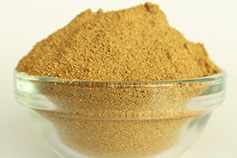
Coriander Powder
Coriander, also known as cilantro and Chinese parsley, is an herb native to Southeastern Europe and is cultivated in Egypt, Middle East, China, India, and Turkey. Coriander powder is made by grinding the dried or roasted seeds of coriander plant. The seeds are small (2-3 mm long), oval in shape, and light brown in color. Coriander powder provides mild-nutty flavor and aroma to many savory and sweet dishes.
Due to its mild-nutty taste and aroma, coriander powder is an essential ingredient in many vegetable and meat curry preparations and barbecue rubs and sauces. It is also added to waffle and pancake mixes and dessert sauces for an enhanced taste.
The presence of coriander powder in food stimulates the taste buds and helps digestion. Including coriander in your diet has many health benefits. It is a great source of potassium, iron, vitamin A, K and C, folic acid, magnesium, and calcium. It is a good source of antioxidants and helps detoxify the body.
Coriander powder is easily available in grocery stores or can be made at home by grinding the coriander seeds. To make coriander powder at home:
Due to its mild-nutty taste and aroma, coriander powder is an essential ingredient in many vegetable and meat curry preparations and barbecue rubs and sauces. It is also added to waffle and pancake mixes and dessert sauces for an enhanced taste.
The presence of coriander powder in food stimulates the taste buds and helps digestion. Including coriander in your diet has many health benefits. It is a great source of potassium, iron, vitamin A, K and C, folic acid, magnesium, and calcium. It is a good source of antioxidants and helps detoxify the body.
Coriander powder is easily available in grocery stores or can be made at home by grinding the coriander seeds. To make coriander powder at home:
- Either dry the coriander seeds in sun for a couple of days or slightly roast the seeds without oil in a pan. Roasting the seeds before grinding enhances the taste and aroma of the coriander powder. Also, drying in sun or roasting removes moisture from the seeds and adds crispness, which helps in powdering the seeds.
- Let the seeds cool and then grind them in a spice grinder. You can also use a coffee grinder for grinding spices; however it’s not recommended to use the same grinder for grinding spices and coffee.
- Store coriander powder in a tightly sealed container in a cool, dark, and dry place. If you are making coriander powder at home, cool it down before storing. It usually last for 4-6 months at room temperature. Refrigerate it for a longer shelf life of 18-24 months.
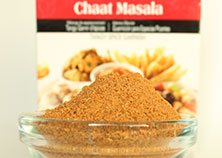
Chaat Masala
Chaat masala is a blend of certain spices that provides extra spiciness and tanginess to the savory dishes. It contains some basic spices found in every South Asian kitchen, such as coriander, cumin, and black pepper as well as some ingredients that are not commonly used, such as dried powdered mint, black salt, dried ginger powder, and dried mango powder. These spices, when blended together, create a distinctive flavor.
Chaat masala is very popular in the cuisines of India, Pakistan, and Bangladesh. It is used in a small quantity, along with other spices, to add more flavor to savory vegetarian dishes and marinades. You can sprinkle chaat masala on salad, lemonade, or even fruits for added zing.
You can buy kebab masala at Indian or South Asian grocery stores. The most popular brands of kebab masala are Shan, Everest, and MDH. It is also available at online grocery stores such as amazon.com.
Chaat masala is very popular in the cuisines of India, Pakistan, and Bangladesh. It is used in a small quantity, along with other spices, to add more flavor to savory vegetarian dishes and marinades. You can sprinkle chaat masala on salad, lemonade, or even fruits for added zing.
You can buy kebab masala at Indian or South Asian grocery stores. The most popular brands of kebab masala are Shan, Everest, and MDH. It is also available at online grocery stores such as amazon.com.
Chaat masala is a blend of certain spices that provides extra spiciness and tanginess to the savory dishes. It contains some basic spices found in every South Asian kitchen, such as coriander, cumin, and black pepper as well as some ingredients that are not commonly used, such as dried powdered mint, black salt, dried ginger powder, and dried mango powder. These spices, when blended together, create a distinctive flavor.
Chaat masala is very popular in the cuisines of India, Pakistan, and Bangladesh. It is used in a small quantity, along with other spices, to add more flavor to savory vegetarian dishes and marinades. You can sprinkle chaat masala on salad, lemonade, or even fruits for added zing.
You can buy kebab masala at Indian or South Asian grocery stores. The most popular brands of kebab masala are Shan, Everest, and MDH. It is also available at online grocery stores such as amazon.com.
Chaat masala is very popular in the cuisines of India, Pakistan, and Bangladesh. It is used in a small quantity, along with other spices, to add more flavor to savory vegetarian dishes and marinades. You can sprinkle chaat masala on salad, lemonade, or even fruits for added zing.
You can buy kebab masala at Indian or South Asian grocery stores. The most popular brands of kebab masala are Shan, Everest, and MDH. It is also available at online grocery stores such as amazon.com.
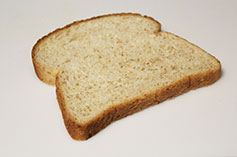
Bread Slices
Coming Soon...

Onion
Most researchers agree that onion has been cultivated for 5000 years or more, and they were first grown in central Asia. Others suggest that onions were first grown in Iran and western Pakistan. Onions can be grown in a variety of soils and climates and are less perishable; therefore, it is believed that they were domesticated simultaneously all over the world. It is interesting to know that Egyptians worshiped onions and believed that concentric rings of onions symbolize eternal life.
Due to pungent taste and smell, humans started onions to protect their plants from animals and insects. The strong flavor of onions comes from sulphur compounds, which onion plants absorb from soil when growing. When an onion is cut, certain enzyme breaks out producing strong sulphurous smell.
Cooking alters the strong and pungent taste of onions into meaty taste that adds flavor to various dishes in many cultures. Onions are also eaten in raw form to garnish many dishes. Cut onions can be rinsed properly to remove sulphur, when eaten raw. You can also put the onions in the freezer for 20-30 minutes to minimize the release of sulphurous smell and taste.
The sulphur compounds, flavonoids (antioxidants), and fructans (small carbohydrate molecules) help prevent cancer, stomach ulcer, and reduce symptoms of diabetes mellitus.
Whole dry onions should be stored at room temperature at dry place with proper ventilation. Do not store onions in closed plastic bags. Netted or punched bags are best to store whole onions for better ventilation, and last upto 4 weeks. Cut onions needs to be refrigerated. Cut onions stored in a sealed container can last up to a week.
Due to pungent taste and smell, humans started onions to protect their plants from animals and insects. The strong flavor of onions comes from sulphur compounds, which onion plants absorb from soil when growing. When an onion is cut, certain enzyme breaks out producing strong sulphurous smell.
Cooking alters the strong and pungent taste of onions into meaty taste that adds flavor to various dishes in many cultures. Onions are also eaten in raw form to garnish many dishes. Cut onions can be rinsed properly to remove sulphur, when eaten raw. You can also put the onions in the freezer for 20-30 minutes to minimize the release of sulphurous smell and taste.
The sulphur compounds, flavonoids (antioxidants), and fructans (small carbohydrate molecules) help prevent cancer, stomach ulcer, and reduce symptoms of diabetes mellitus.
Whole dry onions should be stored at room temperature at dry place with proper ventilation. Do not store onions in closed plastic bags. Netted or punched bags are best to store whole onions for better ventilation, and last upto 4 weeks. Cut onions needs to be refrigerated. Cut onions stored in a sealed container can last up to a week.
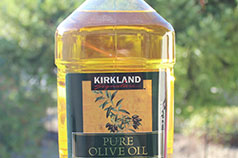
Olive Oil
Olive is one of the oldest known cultivated trees in the world. It is said that Olive trees are being cultivated before the invention of written language. Olive trees are draught tolerant and are native to eastern Mediterranean region. The trees can survive and bear fruits for a thousand year. Olives are small fruits of the Olive tree. During prehistoric time, people use to grind and drain the pulp of olives to get oil for cooking and lighting lamps. Oil extracted from olives was also used for cosmetic purposes.
Today, olive oil is popular than any other oil for culinary use and health benefits. About 90% of the olive fruit produce goes toward the production of olive oil. The oil is produced by pressing the whole olives and is used for cooking, cosmetics, pharmaceutical uses, and as fuel for certain lamps.
Olive oil used for cooking and eating is broadly classified as extra virgin, virgin, pure, and light. The difference is mainly in the process of production of different verities, due to which they contain different levels of antioxidant and have different smoking point.
Extra virgin olive oil is the best quality and is extracted using mechanical process such as cold pressing and centrifugation. The olives are pressed at normal temperature without the use of heating and chemicals. This method of extraction helps preserve most of the antioxidants and hence, makes the oil of high quality. The extra virgin olive oil smokes at a very low temperatures ranging from 200 to 372 degree Fahrenheit depending upon the quality (the better the quality have higher smoking point). Therefore, extra virgin olive oil is considered cold dishes like salad dressing and dips as well as cooking at a medium heat. You can use the good quality extra virgin oil to sauté vegetables, shallow frying eggs, and meats. It’s not recommended to use extra virgin olive oil for deep frying at higher temperatures.
Virgin olive oil is extracted using the same process as extra virgin. It has same levels of monounsaturated fats, antioxidant, and has the similar smoking point. It’s different from extra virgin because it’s made using relatively ripe olives, which gives it light flavor. The usage of virgin oil for cooking is same as extra virgin oil.
Pure olive oil has the same monounsaturated fat content, but has less antioxidant. Pure olive oil, also called olive oil, is a blend of virgin oil and refined pomace oil (also called refined olive oil). Pomace oil, a leftover during the extraction of extra virgin and virgin oils, is refined before mixing it to the virgin oil. The blend contains only about 5 to 10% of virgin oil. It’s lighter in taste, and has higher smoking point that makes it fit for sautéing and frying.
Light olive oil has the same percentage of monounsaturated fat, but lowest level of antioxidants. It’s basically refined olive oil, manufactured by the using some chemical and heat to get rid of impurities. It’s smoking point is highest and is ideal for high temperature cooking, such as deep frying and baking.
At higher temperatures, required for deep frying, extra virgin and virgin oil lose their antioxidant properties and flavor. Therefore, many cooks use pure or light olive oil for frying. Some views suggest that cooking with extra virgin and virgin olive oil at high temperatures is harmful for health; however, there is no substantial evidence to support such views. This might be a myth or a truth. Therefore, to be on the safe side, it’s advisable to use pure and light olive oil for higher temperature cooking such as deep frying, and use good quality extra virgin and virgin olive oil for cold dishes and cooking at medium temperature such as sautéing.
Because of the higher monounsaturated fat content, all kinds of olive oil lasts longer than other oils. After opening, close the cap or lid completely and store in a cool, dark, and dry place, and use it within 3 – 4 months from opening. Due to the presence of antioxidant substances, extra virgin and virgin oils are more resistant to damage by oxygen in air. However, the chlorophyll in the oil makes them vulnerable to damage by light. Therefore, always store the extra virgin and virgin oil in a dark place away from light. Refrigeration slightly solidifies the oil, which comes back to its liquid state when kept at room temperature, but will lose its flavor.
Olive oil has high content of antioxidants called polyphenols, carotenoids, and tocopherols. It’s high in monounsaturated fat and has low saturated and polyunsaturated fat. This composition makes it healthy for heart and for prevention of many medical conditions like, cancer, high blood pressure, and diabetes. According to some recent research, consumption of olive oil improves calcium absorption; hence, prevents the onset osteoporosis.
You can buy olive oil at any grocery store. It is available at online grocery stores such as www.amazon.com. Type the kind of olive oil you want to buy on search bar, you will be able to choose from several options.
Today, olive oil is popular than any other oil for culinary use and health benefits. About 90% of the olive fruit produce goes toward the production of olive oil. The oil is produced by pressing the whole olives and is used for cooking, cosmetics, pharmaceutical uses, and as fuel for certain lamps.
Olive oil used for cooking and eating is broadly classified as extra virgin, virgin, pure, and light. The difference is mainly in the process of production of different verities, due to which they contain different levels of antioxidant and have different smoking point.
Extra virgin olive oil is the best quality and is extracted using mechanical process such as cold pressing and centrifugation. The olives are pressed at normal temperature without the use of heating and chemicals. This method of extraction helps preserve most of the antioxidants and hence, makes the oil of high quality. The extra virgin olive oil smokes at a very low temperatures ranging from 200 to 372 degree Fahrenheit depending upon the quality (the better the quality have higher smoking point). Therefore, extra virgin olive oil is considered cold dishes like salad dressing and dips as well as cooking at a medium heat. You can use the good quality extra virgin oil to sauté vegetables, shallow frying eggs, and meats. It’s not recommended to use extra virgin olive oil for deep frying at higher temperatures.
Virgin olive oil is extracted using the same process as extra virgin. It has same levels of monounsaturated fats, antioxidant, and has the similar smoking point. It’s different from extra virgin because it’s made using relatively ripe olives, which gives it light flavor. The usage of virgin oil for cooking is same as extra virgin oil.
Pure olive oil has the same monounsaturated fat content, but has less antioxidant. Pure olive oil, also called olive oil, is a blend of virgin oil and refined pomace oil (also called refined olive oil). Pomace oil, a leftover during the extraction of extra virgin and virgin oils, is refined before mixing it to the virgin oil. The blend contains only about 5 to 10% of virgin oil. It’s lighter in taste, and has higher smoking point that makes it fit for sautéing and frying.
Light olive oil has the same percentage of monounsaturated fat, but lowest level of antioxidants. It’s basically refined olive oil, manufactured by the using some chemical and heat to get rid of impurities. It’s smoking point is highest and is ideal for high temperature cooking, such as deep frying and baking.
At higher temperatures, required for deep frying, extra virgin and virgin oil lose their antioxidant properties and flavor. Therefore, many cooks use pure or light olive oil for frying. Some views suggest that cooking with extra virgin and virgin olive oil at high temperatures is harmful for health; however, there is no substantial evidence to support such views. This might be a myth or a truth. Therefore, to be on the safe side, it’s advisable to use pure and light olive oil for higher temperature cooking such as deep frying, and use good quality extra virgin and virgin olive oil for cold dishes and cooking at medium temperature such as sautéing.
Because of the higher monounsaturated fat content, all kinds of olive oil lasts longer than other oils. After opening, close the cap or lid completely and store in a cool, dark, and dry place, and use it within 3 – 4 months from opening. Due to the presence of antioxidant substances, extra virgin and virgin oils are more resistant to damage by oxygen in air. However, the chlorophyll in the oil makes them vulnerable to damage by light. Therefore, always store the extra virgin and virgin oil in a dark place away from light. Refrigeration slightly solidifies the oil, which comes back to its liquid state when kept at room temperature, but will lose its flavor.
Olive oil has high content of antioxidants called polyphenols, carotenoids, and tocopherols. It’s high in monounsaturated fat and has low saturated and polyunsaturated fat. This composition makes it healthy for heart and for prevention of many medical conditions like, cancer, high blood pressure, and diabetes. According to some recent research, consumption of olive oil improves calcium absorption; hence, prevents the onset osteoporosis.
You can buy olive oil at any grocery store. It is available at online grocery stores such as www.amazon.com. Type the kind of olive oil you want to buy on search bar, you will be able to choose from several options.
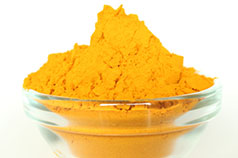
Turmeric Powder
Turmeric powder is a bright and deep yellow colored powder made by grinding dried underground stems of turmeric, which is starchy in nature. In India and some of its neighboring countries, turmeric in stem or powdered form has been used to color skin and clothing and to add color and aroma to food. It is also used as a pious powder during festivals and marriage ceremonies. In other parts of the world, turmeric is mainly used to add color and aroma to food. Turmeric has pungent and bitter taste but musky and mild fragrance.
Turmeric powder is made by steaming or boiling the underground stems in slightly alkaline water (measures above 7.0 on the pH scale) to precook the starch in turmeric. The alkaline water also improves the color of turmeric. Boiled turmeric stems are sun-dried and ground to make powder.
Turmeric powder is mainly used in curries, stir fried dishes, and dry rubs. It is also used in some spicy salad dressing and smoothies and drinks.
The compound called curcuminoids in turmeric is responsible for its yellow color and has antioxidant and preservative properties. Due to its antioxidant properties, use of turmeric in food helps prevent certain type of cancer, lowers cholesterol, lowers the risk of cardiovascular diseases, and protects from Alzheimer’s disease. Due to its preservative property, use of turmeric in food helps in extending the shelf-life of food.
Turmeric has also been used in Indian and Chinese system of medicine as an anti-inflammatory agent to treat various conditions such as toothache, bruises, chest pain, and digestion problems. In addition, turmeric contains very good amounts of minerals like iron, calcium, potassium, manganese, zinc, copper, and magnesium.
Store turmeric powder in a tightly sealed container in a cool, dark, and dry place. At room temperature, turmeric powder will taste fresh for 4 to 6 months. Refrigerate it for a longer shelf-life of up to 2 years.
Turmeric powder is available in Indian and South Asian grocery stores. Some of the popular brands of turmeric powder are Nirav, Deep, SWAD, Spicy World, and Jiva. You may also find it in supermarkets or gourmet markets. It is available at online grocery stores such as amazon.com, where you will be able to choose from several brands.
Turmeric powder is made by steaming or boiling the underground stems in slightly alkaline water (measures above 7.0 on the pH scale) to precook the starch in turmeric. The alkaline water also improves the color of turmeric. Boiled turmeric stems are sun-dried and ground to make powder.
Turmeric powder is mainly used in curries, stir fried dishes, and dry rubs. It is also used in some spicy salad dressing and smoothies and drinks.
The compound called curcuminoids in turmeric is responsible for its yellow color and has antioxidant and preservative properties. Due to its antioxidant properties, use of turmeric in food helps prevent certain type of cancer, lowers cholesterol, lowers the risk of cardiovascular diseases, and protects from Alzheimer’s disease. Due to its preservative property, use of turmeric in food helps in extending the shelf-life of food.
Turmeric has also been used in Indian and Chinese system of medicine as an anti-inflammatory agent to treat various conditions such as toothache, bruises, chest pain, and digestion problems. In addition, turmeric contains very good amounts of minerals like iron, calcium, potassium, manganese, zinc, copper, and magnesium.
Store turmeric powder in a tightly sealed container in a cool, dark, and dry place. At room temperature, turmeric powder will taste fresh for 4 to 6 months. Refrigerate it for a longer shelf-life of up to 2 years.
Turmeric powder is available in Indian and South Asian grocery stores. Some of the popular brands of turmeric powder are Nirav, Deep, SWAD, Spicy World, and Jiva. You may also find it in supermarkets or gourmet markets. It is available at online grocery stores such as amazon.com, where you will be able to choose from several brands.
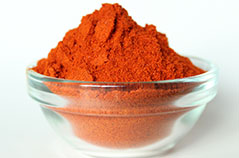
Red Chili Powder
Red chili powder is made by grinding dried deep red-brown thai chili peppers. Native to central and South America, red thai chili peppers were introduced to South Asia in 1500s and now India is the largest producer of these peppers in the world. Either in powdered or whole form, the chili peppers are used to add extra heat and spiciness to the dishes, which is due to the presence of a compound called capsaicin.
Red chili powder is a widely used spice for preparing a variety of curries, soups, stews, marinades, sauces, and dry rubs for barbecue. It is also used to flavor some sweet dishes such as cakes, brownies, truffles, and chocolates.
Red chili powder is a healthy seasoning. It contains significant amount of vitamin A and C, and beta carotenoids (a red-orange pigment that acts as an antioxidant and converts into vitamin A). It also helps to detoxify our body.
When purchasing red chili powder at store, look for the bright red colored powder for best taste. For making red chili powder at home:
Red chili powder is available in Indian and South Asian grocery stores. Some of the popular brands of red chili powder are Nirav, Deep, SWAD, Spicy World, and Everest. You may also find it in supermarkets or gourmet markets. It is available at online grocery stores such as amazon.com, where you will be able to choose from several brands.
Red chili powder is a widely used spice for preparing a variety of curries, soups, stews, marinades, sauces, and dry rubs for barbecue. It is also used to flavor some sweet dishes such as cakes, brownies, truffles, and chocolates.
Red chili powder is a healthy seasoning. It contains significant amount of vitamin A and C, and beta carotenoids (a red-orange pigment that acts as an antioxidant and converts into vitamin A). It also helps to detoxify our body.
When purchasing red chili powder at store, look for the bright red colored powder for best taste. For making red chili powder at home:
- Buy dry (not fresh) whole red thai chili peppers and remove the stems.
- Further dry the chili peppers in sun for a couple of days or slightly roast them for 2-3 minutes, without oil in a pan. Drying or roasting removes moisture from the chili peppers and adds extra crispness, which is required to powder them. Roasting the chili peppers enhances its flavor and aroma.
- Let the dried or roasted chili peppers cool down and then grind to a fine powder in a spice grinder. You can also use a coffee grinder for this purpose; however, the coffee grinder should be used for grinding spices only. It is not advisable to use the same grinder for spices and coffee.
Red chili powder is available in Indian and South Asian grocery stores. Some of the popular brands of red chili powder are Nirav, Deep, SWAD, Spicy World, and Everest. You may also find it in supermarkets or gourmet markets. It is available at online grocery stores such as amazon.com, where you will be able to choose from several brands.
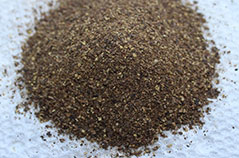
Black Pepper Powder

Red Tomato
Tomatoes started to grow as small berries on bushes in western South America, but were not eaten. Mexicans were the first to use tomatoes in cooking, and gradually tomatoes were used as food throughout the world. However, tomatoes were considered unfit for eating in European countries until early 19th century, due to resemblance with deadly nightshade, a poisonous plant. Around the year 1820, tomatoes started to be seen in European vegetable markets, mainly due to immigration and blending of culture. Italian-Americans ate tomatoes and brought them to Italy. Therefore, Italy was the first European country to cultivate tomatoes for consuming as food.
Today, thousands of varieties of tomatoes are eaten all over the world. You can use any type of red colored tomato for Indian curry recipes. However, for making tomato soup, Roma tomatoes are best as they are relatively dry and have few seeds.
Buy tomatoes that are heavy for its size, firm, and deeply colored. For the best taste, tomatoes should be cooked with skin, outer fleshy wall beneath the skin, and jelly and juice surrounding the seeds, and then strained for fineness. This process helps restore acidity and aroma of the tomatoes. Also, tomato skin contains maximum lycopene, so cooking tomatoes with skin helps in getting more antioxidant in food.
Tomatoes are rich in vitamin A and C, and the red varieties are excellent source of antioxidant carotenoid lycopene (which makes them red). Lycopene in tomatoes may help in reducing the formation of free radicals known to cause cancer. New research has shown that antioxidant power of tomatoes increases when the tomatoes are cooked.
Tomatoes taste best when stored at room temperature. The fresh flavor and aroma of tomatoes is compromised when refrigerated. For best taste and texture, refrigerated tomatoes should be allowed to come back to room temperature before eating.
Today, thousands of varieties of tomatoes are eaten all over the world. You can use any type of red colored tomato for Indian curry recipes. However, for making tomato soup, Roma tomatoes are best as they are relatively dry and have few seeds.
Buy tomatoes that are heavy for its size, firm, and deeply colored. For the best taste, tomatoes should be cooked with skin, outer fleshy wall beneath the skin, and jelly and juice surrounding the seeds, and then strained for fineness. This process helps restore acidity and aroma of the tomatoes. Also, tomato skin contains maximum lycopene, so cooking tomatoes with skin helps in getting more antioxidant in food.
Tomatoes are rich in vitamin A and C, and the red varieties are excellent source of antioxidant carotenoid lycopene (which makes them red). Lycopene in tomatoes may help in reducing the formation of free radicals known to cause cancer. New research has shown that antioxidant power of tomatoes increases when the tomatoes are cooked.
Tomatoes taste best when stored at room temperature. The fresh flavor and aroma of tomatoes is compromised when refrigerated. For best taste and texture, refrigerated tomatoes should be allowed to come back to room temperature before eating.
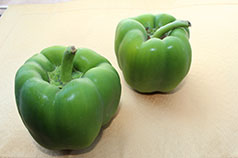
Green Bell Pepper
Share your thoughts and questions!


